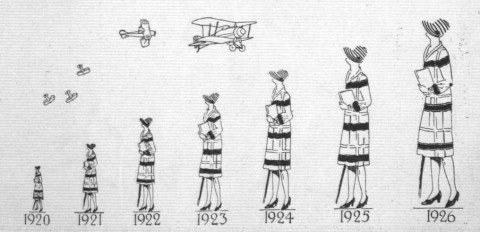
The seventh RAF Display was held on Saturday, 3 July 1926. By now it was, as Flight noted, ‘amongst the foremost of the functions of the London social season’.1 Their Majesties the King and Queen were in attendance, along with representatives of three other royal houses (including the King, Queen, Infante and Infanta of Spain, possibly drawn by the appearance of the Cierva autogyro), ‘Several Indian Princes’, nearly one in three of the combined Houses of Parliament, and about 150,000 less exalted guests. (The graphic above shows the growth of ‘Miss Popularity Hendon’ since the beginning.)2 The main feature of the day was massed formation flying: at one point, six fighter squadrons comprising fifty-four aircraft in total were in the air. The set-piece seems to have suffered by comparison. Flight‘s description seems rather muted when compared to previous years:
After this came the Set Piece — during which the Royal Party made a tour of inspection of the machine park. The “Story” this year was the combined attack on a hostile aerodrome by fighters and day bombers. It commenced with a low bombing attack with light bombs by the fighters, which followed up with a machine-gun attack to silence the ground defences. Next came along, higher up, the day bombers, with the fighters above them in attendance. The bombers then very effectively finished off the aerodrome and previously-damaged aircraft.3
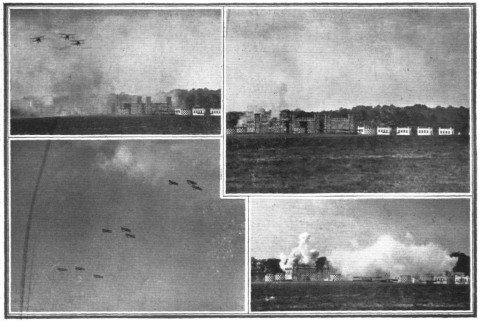
That’s all; you’d need to read the photo captions to even find out that the aircraft involved were Gloster Gamecocks and Fairey Fawns.4 This year’s Pathé newsreel also did not feature the set-piece very prominently, though that may be because the surviving copy looks like unedited footage (the action starts around ten minutes in):

Perhaps the ‘Story’ was lacking? A straightforward attack on an enemy aerodrome lacks the drama of, say, the rescue of a beleaguered garrison. And the apparent lack of a named enemy probably didn’t help either: the previous time the set piece featured an aerodrome it was clearly a German one, but this is now the Locarno era and it wouldn’t do to pick on Germany. Then again, the RAF organisers may have wanted to downplay the set-piece this year for some reason; unusually they scheduled another event afterwards (a competition between flight instructors representing RAF flying schools) which was itself followed by the arrival of the first night bombers to finish a 500-mile cross-country air race which had begun earlier in the day. If the set-piece was intended to be the climax to the Display it was poorly placed in the programme.

Maybe I wasn’t the only one to think so, because in 1927 the set piece was back to its usual form. In a pre-show commentary, F. A. de V. Robertson noted that ‘advance stories of [the set-piece] have aroused the indignation of various bodies who decline to believe that non-Europeans could ever display unkindness towards missionaries’, but predicted that the crowd will ‘none the less enjoy the banging of the guns and bombs, and the glorious flare-up of the village of the disappointed gourmets’.5 Robertson may have got his story wrong, or perhaps the RAF bowed to its critics, for on the day (Saturday, 2 July) the set-piece seems to have been slightly different: the scene is ‘the Eastern village of Hunyadi Janos, in Irquestine’ but there are ‘European settlers’ in it alongside the indigenous inhabitants.6 Irquestine sounds like Iraq plus Palestine, both areas under British control, but the name of the village suggests Eastern Europe. Perhaps something can be read into the fact that that Hunyadi was a great (European and Christian) commander who held off the (Islamic) armies of the Turks.
Anyway, the Europeans in Hunyadi Janos come under attack for some reason:
as the white women and children (quite healthy youngsters, the latter) escaped into the open, No. 12 Squadron (Fox bombers) flew over from Andover and commenced a repeated series of attacks on the village and natives.7
As ‘the Europeans, hard pressed by the pretty-coloured natives, were starving’, provisions are dropped to them from DH.9as via parachute.7
While the Foxes continued to bomb the village — by now well alight, even to the “mud” fort — three “Queen Victorias” (as per loud speaker) arrived on the scene, deplaned reinforcements with machine guns, emplaned the women and children, and flew off with them to a place of safety. The sounding of the “Cease Fire” by R.A.F. trumpeters, and the departure of Their Majesties marked the end of a perfect day.7
British Pathé this time featured the set-piece prominently in their Hendon newsreel:

So it was both an exciting drama and served as the end of the day’s entertainment. Interestingly, it did have a competitor in the form of a mock ‘air battle or daylight attack on London’, which Flight described as ‘splendidly “staged,” and immensely thrilling’.8 The bombers (DH9as and Hyderabads) did not get through the Grebe fighter defences. Advance publicity for Hendon (in the form of a newsreel — check out the special effect searchlights!) promised that ‘The supreme thrill will be an “Aerial Battle in the defence of London”‘ and showed aircraft flying at night, so perhaps this is further evidence of a late change to the programme.

I don’t think the above was official advertising for the ninth RAF Display: it doesn’t have the date, Saturday, 30 June 1928, on it, which would be pretty poor event planning. It’s on the cover of Flight‘s own souvenir programme which formed part of the issue published just before the Display.9 They clearly went to a lot of trouble over this (there are large photographs of all the aircraft involved, one to a page, so that spectators can identify what they are looking at), and it was doubtless their highest-selling issue of the year. Hendon by now was the biggest event in the airminded calendar, even if crowds seem to have plateaued at 150,000.
The bombing attack on London was repeated this year, though Flight doesn’t describe it as such in its account. Perhaps that’s because, as Robertson noted before the event, that the air defence exercises held around and over London the previous summer had shown the public that their defenders were all too easy to evade.10
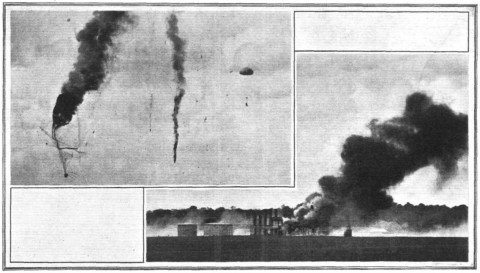
In any case, the actual set-piece received star billing, even if it didn’t quite live up to its advance publicity. This was, as seen above, a mock attack on an oil refinery.11 So this immediately tells us we’re back in the realm of total war, rather than air control. The role of Fleet Air Arm aircraft seems to have been bigger than in the previous naval-themed set-pieces, suggesting that co-operation has trumped substitution, for now. (Although the FAA was still part of the RAF.)
An oil refinery containing the enemy’s supply of fuel was the objective of a British aircraft carrier, which despatched ships’ fighters (Fairey “Flycatchers“) to attack the adjoining anti-aircraft defences so as to disorganise them whilst the bombing machines arrived. An enemy observation balloon sighted them and gave warning, but it was attacked and shot down in flames, the observer, “Miss November,” descending by parachute.7
Sadly it seems that the burning balloon set the refinery on fire before the bombers could do it,
but the tanks themselves still required annihilating, and when the Fairey III.F reconnaissance machines arrived from the aircraft carrier they were partly blown up. D.H.9a’s from a shore base then appeared, dropped their loads, and the whole destruction was thoroughly and neatly completed.7
While in some ways this is a reversion to the aerodrome set-piece of 1926, at least there is a bit more of a narrative, and some human interest in the form of ‘Miss November’. Although I must say I don’t understand this reference. Why a female observer in the balloon? Why is she called ‘Miss November’? Maybe it is meant to be a hint that the enemy in the set piece is the Soviet Union: I’m thinking of the Women’s Battalions formed in Russia in 1917, though they were not Bolshevik units, and that the October Revolution took place in November in the Gregorian calendar. But maybe I’m reading too much into too little; it’s probably just some obscure pop-cultural reference which would be obvious to all then and nobody now.
![]() This work is licensed under a Creative Commons Attribution-NonCommercial-NoDerivatives 4.0 International License.
Permissions beyond the scope of this license may be available at http://airminded.org/copyright/.
This work is licensed under a Creative Commons Attribution-NonCommercial-NoDerivatives 4.0 International License.
Permissions beyond the scope of this license may be available at http://airminded.org/copyright/.

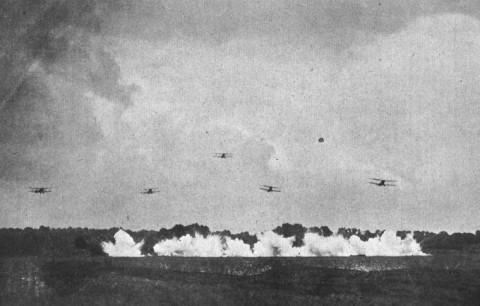

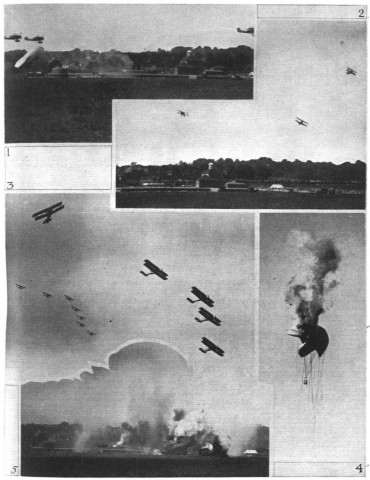
I wanted to make a comment about how the timeframe for admirals and air marshals “forgetting the lessons of World War I” is getting shorter and shorter.
But, i) I’m not sure that I can pull it off; and ii) I’m now obsessed with imagining “memes of 1927.” I think that Miss November may have played a keyboard, but I’m not exactly sure.
I think one of the forgotten lessons of WWI was ‘don’t make obscure jokes that historians writing 80 years later won’t get’.
Pingback: Airminded · Ending Hendon — IV: 1929-1931
Pingback: Airminded · Comparing Hendon
Pingback: Hendon in stereo – Airminded